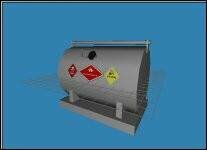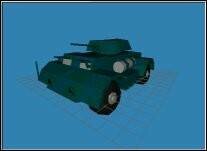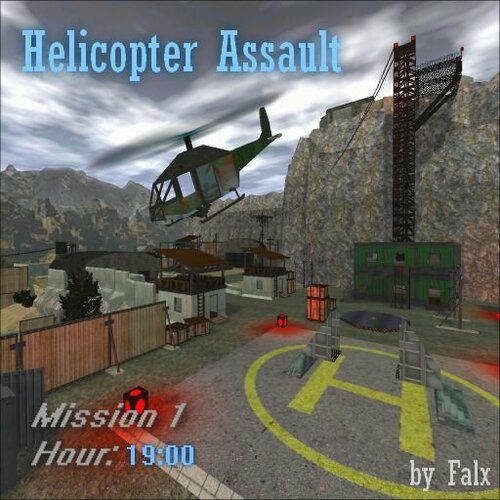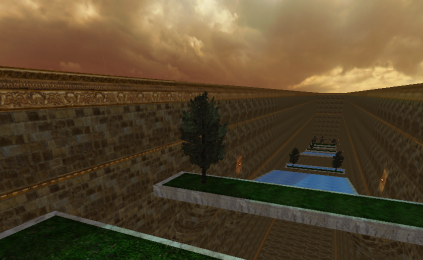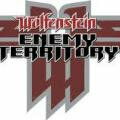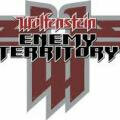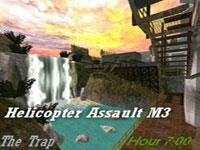PREFABS
53 files
-
fuel_tank
By kate
Fuel_Tank By [rD]MrPink
Specifications of fuel tank:
Options:
Gravity fitting.
Water Draw-off
OSHA Ladders and catwalks.
Custom coatings (interior and exterior).
Integral spill containment (double-wall).
Overfill catch basins (various sizes).
Fill-limiters.
Remote gauging systems.
Fittings including overfill protection, fill caps, vent caps and others.
Standard Features:
Emergency vent riser (24 inches) and emergency vent cap.
Openings are female national pipe thread (FPNT).
Tanks 5,000 gallons and over are supplied with an 18" manhole per UL-142.
Tanks are designed for stationary use and require some sort of support structure.
Exterior paint is red iron oxide primer, interior is unpainted.
All UL-142 tanks include (2) 2" FNPT fittings in the top of the tank
Nominal Gallons
Diameter
Length
Steel Thickness
Weight (Lbs)
Normal Vent
Emergency Vent
Comments
300
38.5"
5'-0"
12 Ga
300
1 1/4
4" C&B
375
38.5"
6'-4"
12 Ga
300
1 1/4
4" C&B
Containment for 300
500
45.5"
6'-0"
12 Ga
400
1 1/4
4" OPW 202
600
45.5"
7'-4"
12 Ga
500
1 1/4
4" OPW 202
Containment for 500
550
48.0"
6'-0"
12 Ga
400
1 1/4
4" OPW 202
650
48.0"
7'-4"
12 Ga
500
1 1/4
4" OPW 202
Containment for 550
1,000
64.0"
6'-0"
10 Ga.
820
1 1/4
4" OPW 202
1,200
64.0"
7'-4"
10 Ga.
1,300
1 1/4
6" C&B
Containment for 1,000
1,100
64.0"
6'-8"
10 Ga.
1,200
1 1/4
4" OPW 202
1,300
64.0"
8'-0"
10 Ga.
1,400
1 1/4
6" C&B
Containment for 1,100
1,500
64.0"
9'-0"
3/16
1,500
1 1/4
6" C&B
2,000
64.0"
12’-0"
3/16
1,900
1 1/4
6" OPW 202
2,000
75.5"
9’-0"
3/16
1,800
1 1/4
6" OPW 202
2,500
75.5"
11’-0"
3/16
2,100
1 1/2
6" OPW 202
3,000
75.5"
13’-0"
3/16
2,400
2
8" C&B
3,500
75.5"
15’-0"
3/16
2,700
2
6" OPW 202
4,000
75.5"
17’-0"
3/16
3,000
2
8" C&B
5,000
95.5"
14’-0"
1/4
4,600
2
8" Morrison 244M
5,500
95.5"
14'-8"
1/4
4,800
2
8" Morrison 244M
Containment for 5,000
6,000
95.5"
17’-0"
1/4
5,400
2
8" Morrison 244M
6,500
119.0"
11’-0"
1/4
5,100
2
8" Morrison 244M
7,000
95.5"
19’-6"
1/4
6,000
2
8" Morrison 244M
7,500
95.5"
21’-0"
1/4
6,400
2
8" Morrison 244M
8,000
95.5"
22’-0"
1/4
6,600
2
8" Morrison 244M
8,000
119.0"
14’-0"
1/4
6,000
2
8" Morrison 244M
10,000
95.5"
28’-0"
1/4
8,200
2 1/2
8" Morrison 244M
10,000
119.0"
17’-6"
1/4
7,100
2 1/2
8" Morrison 244M
12,000
95.5"
33’-0"
1/4
9,400
2 1/2
8" Morrison 244M
12,000
119.0"
21’-0"
1/4
8,300
2 1/2
8" Morrison 244M
15,000
95.5"
41'-0"
1/4
11,500
2 1/2
10" Morrison 244F
15,000
98.0"
38'-6"
1/4
11,200
2 1/2
10" Morrison 244F
15,000
119.0"
26’-0"
1/4
9,800
2 1/2
8" Morrison 244M
20,000
119.0"
35’-0"
1/4
12,700
3
10" Morrison 244F
25,000
132.0"
36’-0"
1/4
14,600
3
10" Morrison 244F
Note: dimensions and weight are approximate.
Thanks to Greer Tanks.
Instructions:
Unzip the zip file into your ETMain Directory, if you get a warning about directories
already in this folder, click yes, I wont hurt anything. You must ALSO unzip this into any
.pk3s you put your map in. You will find the model in gamemain/models/mapobjects/[rD]MrPink.
It is called Fuel_Tank.md3
7 downloads
(0 reviews)0 comments
Submitted
-
staghound
By kate
Staghound_Armored Car By [rD]MrPink
History of the Chevrolet T17E1 Staghound Armored Car:
Staghound Armoured Car T17 El: 1942+
Length: 5.48m, Width: 2.69m, Height: 2.36m , Weight: 13.95 tonnes
Crew: 5 Power-plant: Two GMC 6-cyl. petrol engines, each 97 bhp at 3000 rpm. Power steering
and an automatic gearbox were standard. However, the gearbox lacked high speed reverse (a
desirable feature in any reconnaissance vehicle).
Armament: 1 x 37mm (stabilised) gun M6 with 103 rounds and power traverse, 2 x .30 cal
Browning Mg.
Armour: 9-45mm. Speed: 90 kph
Range: 725km
Maker: Chevrolet Division, General Motors Corporation, USA.
The Staghound was the product of a joint effort in 1942 by British and American military
staff, to draw up specifications for an armoured car. Approximately 3,000 of the original
design were produced. A further 1,000 anti-aircraft models (mounting twin .50 cal Browning
Mg.) were also manufactured. The standard vehicle T17 El was named the Staghound and was a
4 x 4 car with a turret mounting a 37mm gun. Some vehicles were subsequently refitted with a
3 inch tank howitzer for infantry close support.
Thanks to www.lancers.org.au
Many Thanks to Lydia Ferrero
Instructions:
Unzip the zip file into your ETMain Directory, if you get a warning about directories
already in this folder, click yes, I wont hurt anything. You must ALSO unzip this into any
.pk3s you put your map in. You will find the model in gamemain/models/mapobjects/[rD]MrPink.
It is called Staghound_Armored.md3
7 downloads
(0 reviews)0 comments
Submitted
-
c-47_dakota
By kate
C-47_Dakota By [rD]MrPink
Created as per request of SuperC of the splash Damage forums
History of the Douglas C-47 Dakota "Gooney Bird":
The Douglas DC-3 was born of the intense competition for modern commercial aircraft that
characterized the post-World War I era. It was the direct descendant of the DC-1, which
first flew in 1933 as Douglas' initial response to a short supply of competitor, Boeing
Aircraft's, landmark 10-passenger 247, the first, low-wing, all-metal airliner. With only
one 12-passenger sample flying, and already a record-breaking success, the DC-1 was quickly
made obsolete, replaced by an a more powerful version with greater seating capacity, the
14-passenger DC-2, of which 193 were built. When, in 1934, American Airlines asked Douglas
for a larger version of the DC-2 that would permit sleeping accommodations for
transcontinental flights, Douglas responded with the 24 passenger (16 as a "sleeper" craft)
DST (Douglas Sleeper Transport), the 24-passenger version of which was designated DC-3.
The DC-3 is given most of the credit for an almost 600% increase in airline passenger
traffic between 1936 and 1941. Recognizing its great potential as a military transport, the
United States Army specified a number of changes needed to make the aircraft acceptable for
military use, including more powerful engines, the removal of airline seating in favor of
utility seats along the walls, a stronger rear fuselage and floor, and the addition of large
loading doors. A large order was placed in 1940 for the military DC-3, which was designated
C-47 and became known as "Skytrain," a name it would soon be asked to live up to. Used as a
cargo transport to fly the notorious "Hump" over the Himalayas after the Japanese closed the
Burma Road, and as a paratroop carrier in various campaigns from Normandy to New Guinea, the
Douglas C-47 was one of the prime people movers of WWII where, in one form or another, it
was manufactured by belligerents on both sides, after first having been licensed to Mitsui
before the Japanese attack on Pearl Harbor, and to the Russians, who manufactured it under
license as the Lisunov Li-2. During the war, Mitsui built their own version, via contract
with the Showa and Nakajima companies, which built about 485 "Tabbys" (the code name given
to the aircraft by the Allies) as the Showa L2D. Known also as "Dakota" (British
designation), R4D (U.S. Navy), "Skytrooper" and "Gooney Bird," the Douglas C-47 (USAAF) went
through many modifications during its long service life, largely with respect to engine
power ratings, but also with structural modifications for specific tasks like reconnaissance
and navigation training. It was even tested as a floatplane, and as an engineless glider, a
task it performed well, but too late in the war to matter. It was also used as a fighting
machine as the AC-47D gunship ( "Puff, the Magic Dragon") of the Vietnam war, where the
plane was equipped with three modernized Gattling guns (General Electric 7.62mm "Miniguns,"
each mounted and firing from the port side) for use as a "target suppressor," circling a
target and laying down massive fire to eliminate or at least subdue the enemy position.
By war's end, 10,692 of the DC-3/C-47 aircraft had been built, with 2,000 Li-2s by the
Soviets, and 485 Showa L2Ds by the Japanese, for a total of about 13,177. Between its first
flight on December 17, 1935, and this writing, the DC-3 will have had 65 years of continuous
service. From its pioneering of military airlifts over the hump, to its perfecting of the
technique during the Berlin Airlift, the C-47 has been prized for its versatility and
dependability, factors that explain its remarkable longevity as an active carrier worldwide.
[History by Kevin Murphy] Thanks to Tex Gehman.
Specifications (C-47):
Engines: Two 1,200-hp Pratt & Whitney R-1830-S1C3G Twin Wasp radial piston engines
Weight: Empty 16,865 lbs., Max Takeoff 25,200 lbs.
Wing Span: 95ft. 0in.
Length: 64ft. 5.5in.
Height: 16ft. 11.5in.
Performance:
Maximum Speed: 230 mph
Cruising Speed: 207 mph
Ceiling: 23,200 ft.
Range: 2,125 miles
Armament: None
Number Built:
13,177 (All manufacturers)
Instructions:
Unzip the zip file into your ETMain Directory, if you get a warning about directories
already in this folder, click yes, I wont hurt anything. You must ALSO unzip this into any
.pk3s you put your map in.
9 downloads
(0 reviews)0 comments
Submitted

